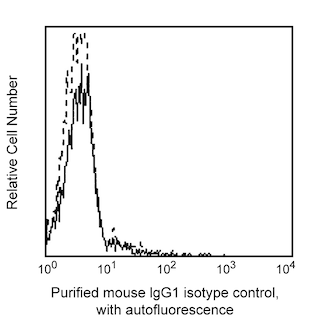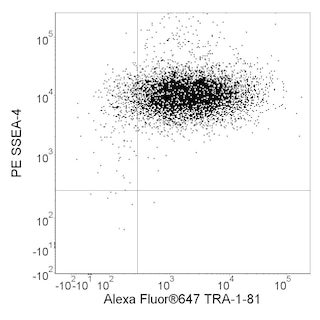-
Your selected country is
Middle East / Africa
- Change country/language
Old Browser
This page has been recently translated and is available in French now.
Looks like you're visiting us from {countryName}.
Would you like to stay on the current country site or be switched to your country?






Flow Cytometric Analysis of ASGPR 1 expression in Human Hepatocellular Carcinoma (Hep G2) cells. Hep G2 cells (ATCC, HB-8065) were harvested using BD™ Accutase™ Cell Detachment Solution (Cat. No. 561527). The cells were stained with either Purified Mouse IgG1, κ Isotype Control (Cat. No. 554121; dashed line histogram) or Purified Mouse Anti-ASGPR 1 antibody (Cat. No. 563654; solid line histogram) at matched concentrations. The second-step reagent was PE Goat Anti-Mouse Ig (Cat. No. 550589). Histograms were derived from gated events based on light-scattering characteristics of viable Hep G2 cells. Flow cytometric analysis was performed using a BD LSRFortessa™ Flow Cytometry System.

Immunofluorescent Staining of ASGPR 1 in Human Hepatocellular Carcinoma (Hep G2) cells. Hep G2 cells (ATCC, HB-8065) were fixed with BD Cytofix™ Fixation Buffer (Cat. No. 554655) and stained with Purified Mouse Anti-ASGPR 1 (pseudo-colored green) at 5 μg/mL. The second-step reagent was Alexa Fluor® 488 Goat Anti-Mouse IgG (Life Technologies), and counter-staining was with DAPI (4',6-Diamidino-2-phenylindole dihydrochloride; pseudo-colored blue). The images were captured on a BD Pathway™ 435 Cell Analyzer and merged using BD AttoVision™ Software.


BD Pharmingen™ Purified Mouse Anti-ASGPR 1

BD Pharmingen™ Purified Mouse Anti-ASGPR 1

Regulatory Status Legend
Any use of products other than the permitted use without the express written authorization of Becton, Dickinson and Company is strictly prohibited.
Preparation And Storage
Product Notices
- Since applications vary, each investigator should titrate the reagent to obtain optimal results.
- An isotype control should be used at the same concentration as the antibody of interest.
- Sodium azide is a reversible inhibitor of oxidative metabolism; therefore, antibody preparations containing this preservative agent must not be used in cell cultures nor injected into animals. Sodium azide may be removed by washing stained cells or plate-bound antibody or dialyzing soluble antibody in sodium azide-free buffer. Since endotoxin may also affect the results of functional studies, we recommend the NA/LE (No Azide/Low Endotoxin) antibody format, if available, for in vitro and in vivo use.
- Caution: Sodium azide yields highly toxic hydrazoic acid under acidic conditions. Dilute azide compounds in running water before discarding to avoid accumulation of potentially explosive deposits in plumbing.
- Accutase is a registered trademark of Innovative Cell Technologies, Inc.
- Please refer to www.bdbiosciences.com/us/s/resources for technical protocols.
Companion Products




.png?imwidth=320)
The 8D7 monoclonal antibody recognizes Asialoglycoprotein receptor 1 (ASGPR 1), also known as Hepatic lectin H1 (HL-1). ASGPR 1 is an approximately 42 kDA type II integral membrane protein that is expressed on the surface of hepatic cells. It is expressed by hepatocytes on the sinusoidal-lateral plasma membrane but not on the bile canalicular membrane. ASGPR 1 plays a role in serum glycoprotein homeostasis. It functions as a subunit of the Asialoglycoprotein receptor (ASGPR) complex that binds, internalizes, and transports various glycoproteins for lysosomal degradation. The receptor may also promote hepatic infection by the binding and uptake of various viruses. The immunogen used to generate the 8D7 hybridoma was rat liver membrane extracts. Rat ASGPR consists of three polypeptide subunits (Rat hepatic lectin 1-3 (RHL1-3). The 8D7 antibody has been shown to react with a subunit-specific epitope on RHL-1. Clone 8D7 cross-reacts with human ASGPR 1.
Development References (3)
-
Mizuno M, Yamada G, Nagashima H. Development of a monoclonal antibody identifying an antigen which is segregated to the sinusoidal and lateral plasma membranes of rat hepatocytes. J Gastroenterol. 1986; 21(3):238-244. (Immunogen). View Reference
-
Shimada M, Mizuno M, Uesu T, et al. A monoclonal antibody to rat asialoglycoprotein receptor that recognizes an epitope specific to its major subunit. Hepatol Res. 2003; 26(1):55-60. (Clone-specific: Flow cytometry, Immunofluorescence, Immunohistochemistry). View Reference
-
Touboul T, Hannan NR, Corbineau S, et al. Generation of functional hepatocytes from human embryonic stem cells under chemically defined conditions that recapitulate liver development. Hepatology. 2010; 51(5):1754-1765. (Biology: Array). View Reference
Please refer to Support Documents for Quality Certificates
Global - Refer to manufacturer's instructions for use and related User Manuals and Technical data sheets before using this products as described
Comparisons, where applicable, are made against older BD Technology, manual methods or are general performance claims. Comparisons are not made against non-BD technologies, unless otherwise noted.
For Research Use Only. Not for use in diagnostic or therapeutic procedures.
Report a Site Issue
This form is intended to help us improve our website experience. For other support, please visit our Contact Us page.